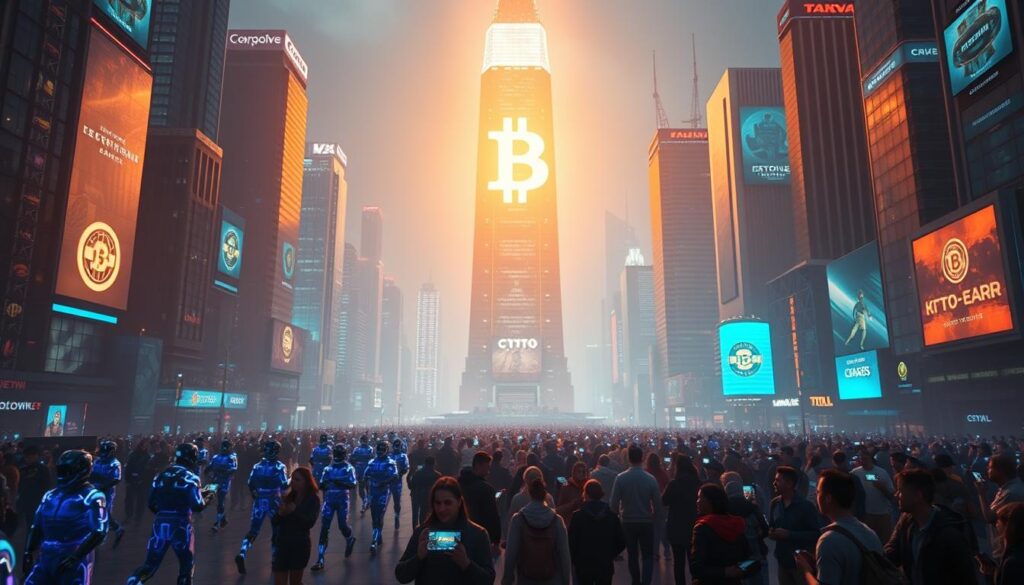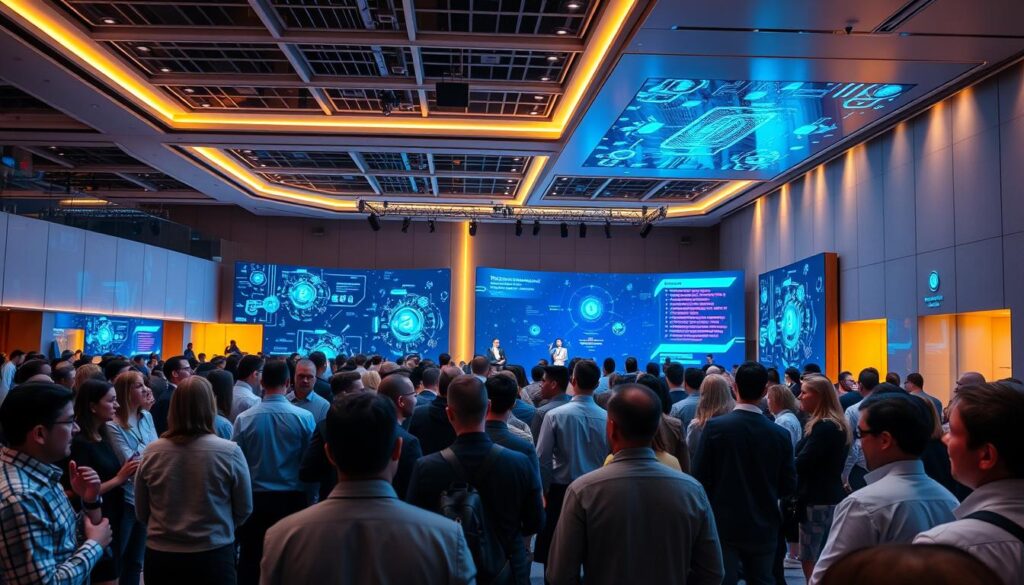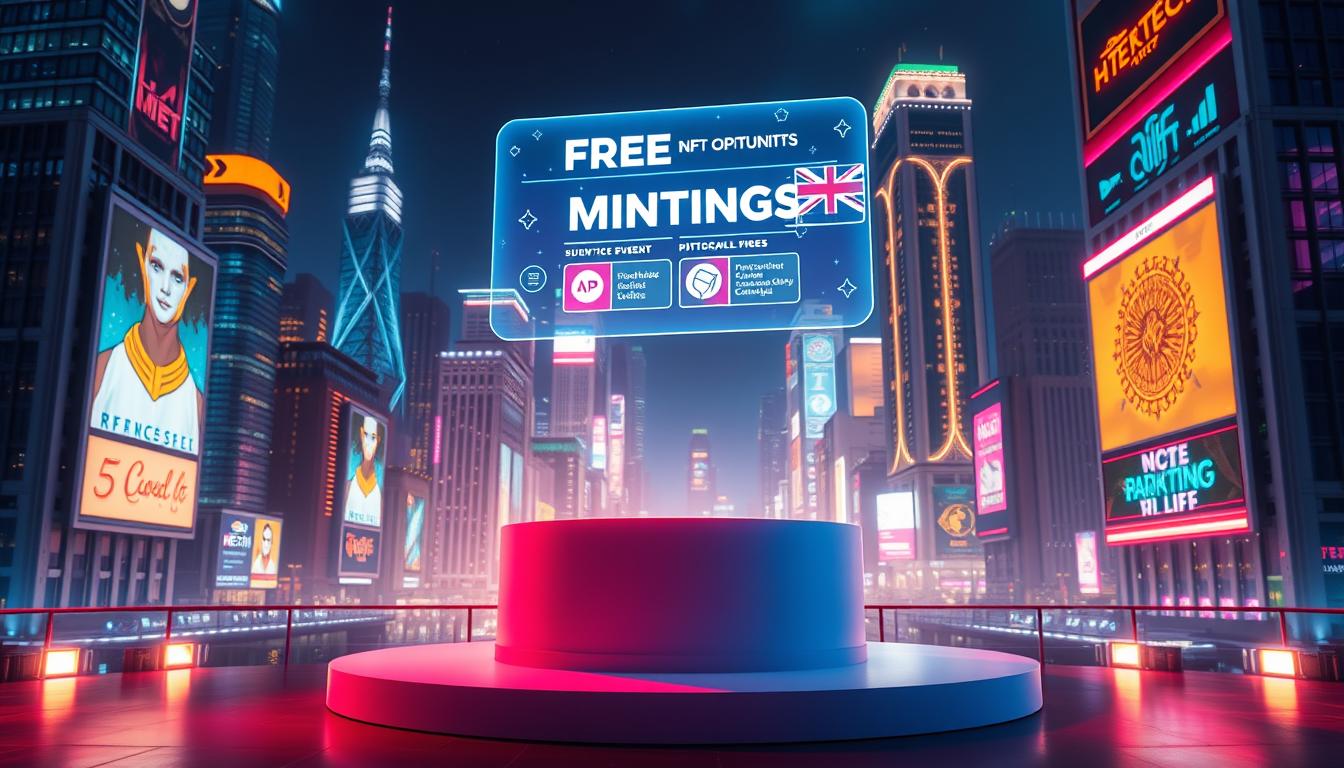Now Reading: How to Make Money in the Metaverse with Cryptocurrency: Tips
- 01
How to Make Money in the Metaverse with Cryptocurrency: Tips
How to Make Money in the Metaverse with Cryptocurrency: Tips

The digital frontier is expanding at an incredible pace. The global metaverse market, valued at $130 billion in 2024, is projected to surge past $2 trillion by 2032. This virtual universe offers more than just games; it’s a new economic landscape.
This guide explores the vast opportunities available. Platforms like Decentraland and The Sandbox use blockchain technology to create immersive worlds. Here, users interact, work, and build using digital assets.
Cryptocurrency acts as the primary currency for these virtual spaces. It powers transactions for everything from virtual land to concert tickets. Understanding this ecosystem is key to unlocking its potential for generating money.
We will outline proven ways to participate in this booming metaverse economy. The opportunities range from creative ventures to strategic investments, catering to various skill levels.
Key Takeaways
- The metaverse represents a multi-trillion dollar economic opportunity with rapid growth.
- Cryptocurrency is the foundational currency for all transactions within most virtual worlds.
- This digital economy allows for the creation, purchase, and sale of unique digital assets.
- Major platforms are building interconnected 3D spaces that replicate real-world experiences.
- Income generation spans from entry-level activities to advanced technical and investment roles.
- Success requires a solid understanding of both virtual world mechanics and crypto fundamentals.
Understanding the Metaverse Landscape
A new dimension of human experience is unfolding through immersive virtual environments. This digital frontier represents a fundamental shift in how people connect and interact online.
What Is the Metaverse?
The metaverse is an interconnected network of 3D virtual spaces. Users access these environments through avatars, creating persistent digital identities. This virtual world combines technologies like virtual reality and augmented reality.
Unlike traditional websites, the metaverse offers real-time, interactive experiences. Users can attend concerts, explore museums, or conduct business meetings in fully realized 3D spaces. Major platforms like Decentraland and The Sandbox lead this development.
Virtual and Physical World Comparisons
The virtual world mirrors many activities from our physical world. Shopping, socializing, and working all have digital counterparts. However, the metaverse transcends geographical limitations.
This digital environment enhances reality rather than replacing it. Users need compatible devices like VR headsets for full immersion. Mobile and browser access make these experiences increasingly accessible to everyone.
The evolution focuses on human-centered design. These spaces move beyond novelty to become essential for digital interaction and commerce.
how to make money in the metaverse with cryptocurrency
At the heart of every transaction within immersive digital worlds lies a powerful tool: cryptocurrency. This digital currency forms the economic backbone, enabling users to participate fully.
Cryptocurrency’s Role in Virtual Transactions
Each major platform operates with its own native token. Decentraland uses MANA, The Sandbox uses SAND, and Axie Infinity uses AXS. These tokens power all activities, from governance to rewards.
Users acquire these assets through digital wallets. They can then purchase virtual land, avatar accessories, event tickets, and unique NFTs. This creates a seamless economy for digital value.
Blockchain technology secures every exchange. It provides transparency and proof of ownership for all digital assets. This system offers significant advantages over traditional payment methods.
| Feature | Traditional Finance | Metaverse Cryptocurrency |
|---|---|---|
| Transaction Speed | Days for international transfers | Near-instantaneous |
| Transaction Fees | Often high, especially internationally | Typically lower |
| Accessibility | Requires bank account or credit card | Open to anyone with an internet connection |
| Identity | Linked to personal identity | Can be pseudonymous |
Profiting involves several strategies. These include holding appreciating tokens, earning through platform activities, and trading on exchanges. A solid grasp of crypto fundamentals is essential for success.
Exploring Virtual Real Estate Opportunities
Property acquisition in virtual worlds offers substantial financial potential for forward-thinking investors. The global metaverse real estate market reached $3 billion in 2024. Projections show growth to $54.95 billion by 2033.
Investing in Digital Land
Major platforms like Decentraland and The Sandbox enable digital assets ownership. High-profile purchases demonstrate confidence in this emerging market. Tokens.com invested $2.4 million in Decentraland property. Brands like Adidas acquired substantial estate holdings.
Successful investment strategies involve careful evaluation. Consider platform popularity and virtual location proximity. Community strength and planned developments impact property value.
Ownership is recorded on blockchain as NFTs. This provides verifiable proof without traditional intermediaries. Each platform has specific rules requiring thorough understanding.
Investors should acknowledge the risk factors involved. Market volatility and platform adoption uncertainty exist. Diversification and research help mitigate potential challenges.
Becoming a Virtual Real Estate Agent
Digital land transactions require specialized expertise that creates opportunities for skilled intermediaries. The global virtual property market reached $3 billion in 2024. Projections show growth to $54.95 billion by 2033.

Virtual brokers provide essential services for people navigating property deals. They handle valuation, market analysis, and transaction guidance. Commissions typically range from 3% to 10% of sale prices.
Specializing in platforms like Decentraland or The Sandbox builds valuable expertise. Understanding platform-specific features and pricing trends enhances service quality. This knowledge helps clients make informed decisions.
| Aspect | Traditional Brokerage | Virtual Brokerage |
|---|---|---|
| Transaction Medium | Physical properties and offices | Digital platforms and NFTs |
| Payment Method | Traditional currency and financing | Cryptocurrency and digital wallets |
| Market Hours | Standard business hours | 24/7 global accessibility |
| Commission Structure | Typically 5-6% | 3-10% depending on platform |
| Required Expertise | Local market knowledge | Platform-specific technical skills |
Starting requires building platform knowledge and community connections. Establishing credibility through social media presence attracts clients. This profession offers substantial income potential in the expanding digital real estate sector.
Monetizing as a Metaverse Marketer
Brands are racing to establish a foothold in immersive digital spaces. This creates a high demand for skilled professionals who understand marketing in these new environments. Specialists help companies build presence and engage users.
Developing Immersive Advertising Strategies
Successful metaverse campaigns go beyond simple banners. They create interactive experiences. This includes virtual storefronts, branded games, and live events.
For example, Shipt partnered with the Roblox game Driving Empire. This placed the brand directly into a popular gaming community. Such integrations feel natural to users.
Effective marketing requires deep platform knowledge. Understanding what resonates with each virtual world’s audience is crucial. This leads to higher engagement and better results for companies.
| Feature | Traditional Marketing | Metaverse Marketing |
|---|---|---|
| Primary Audience | Broad demographics | Engaged digital communities |
| Interaction Level | Mostly passive viewing | Fully interactive experiences |
| Measurement | Click-through rates, impressions | User engagement time, asset interactions |
| Creative Assets | Images, videos, text | 3D models, interactive games, virtual events |
Career paths include roles like Gaming Marketing Manager. The median salary for digital marketing specialists is $73,000. Entering this metaverse field now offers a significant first-mover advantage.
Selling Virtual and Physical Products in the Metaverse
Digital storefronts are transforming how consumers interact with brands across virtual spaces. Creators can design unique digital items like avatar clothing, accessories, and 3D art. Major platforms provide marketplaces where these virtual products find eager buyers.
Digital Product Sales Techniques
Platforms like Roblox and Decentraland offer built-in marketplaces for creators. These spaces allow direct sales of digital assets to engaged communities. Successful strategies often involve creating limited-edition releases.
Scarcity drives significant value in virtual goods markets. Gucci launched a virtual handbag on Roblox that initially sold for $6. The same digital item later resold for over $4,000, demonstrating remarkable appreciation.
Using NFTs verifies authenticity and ownership of digital creations. This technology ensures each item remains unique and traceable. Proper pricing strategies consider platform demographics and product rarity.
Bridging Virtual Experiences with Real-World Goods
Many companies now connect digital and physical product experiences. Nike created digital sneakers called Dunk Genesis CRYPTOKICKS with RTFKT. Owners of these NFTs could claim physical versions of their virtual footwear.
Virtual showrooms create immersive shopping experiences for customers. Users can interact with 3D product models before purchasing physical items. This approach builds brand engagement across digital and real-world channels.
These hybrid models demonstrate creative ways to generate revenue. Many people find success by blending digital creativity with traditional commerce. The metaverse continues to offer innovative sales opportunities.
Earning Through NFT Creation and Trading
The $11.3 billion NFT market represents one of the fastest-growing segments in digital commerce. These unique digital assets create exciting revenue streams for creators and investors alike.
Understanding NFT Value and Scarcity
Non-fungible tokens are unique digital items stored on blockchain networks. Each NFT contains verifiable proof of ownership and authenticity. This technology prevents counterfeiting and establishes clear asset history.
Value comes from controlled supply and exclusivity. Limited edition digital collections function like rare physical items. Scarcity drives demand and market prices for these special assets.
| Platform | Blockchain | Royalty Options | Primary Focus |
|---|---|---|---|
| OpenSea | Ethereum, Polygon | Up to 10% | General Collectibles |
| Rarible | Ethereum, Flow | Customizable | Creator Economy |
| Magic Eden | Solana | Standard 5-10% | Gaming Assets |
| Foundation | Ethereum | 10% Standard | Digital Art |
Creators earn through initial sales and secondary market royalties. Each resale generates passive income through smart contract percentages. This creates sustainable revenue beyond the first transaction.
Successful NFT investment requires research and diversification. Understanding community demand and project roadmaps helps identify valuable opportunities. Like any investment, these digital assets carry market risks.
Building a Metaverse Presence as an Influencer
The rise of immersive platforms has given birth to a new type of digital celebrity: the metaverse influencer. These creators build influential presences using custom avatars within 3D virtual worlds. They engage with a dedicated community and unlock various revenue streams.

Establishing a presence starts with creating a distinctive avatar identity. Consistent participation in platform events and conversations is key. Growing a loyal following requires producing engaging content that resonates with specific audiences.
Monetization comes through brand partnerships and sponsorships. Influencers showcase virtual products or host branded events. Affiliate programs, like Shopify Collabs, offer a streamlined way to earn commissions.
| Aspect | Traditional Influencer | Metaverse Influencer |
|---|---|---|
| Primary Platform | Instagram, TikTok, YouTube | Decentraland, The Sandbox, Roblox |
| Content Format | Photos, videos, stories | Avatar experiences, virtual events, 3D spaces |
| Audience Interaction | Comments, likes, shares | Real-time avatar interaction, co-experiences |
| Monetization Methods | Sponsored posts, affiliate links | Virtual product placement, event hosting, NFT collaborations |
Successful influencers often focus on a niche. This could be virtual fashion, digital art, or gaming. Specialization helps build authority and attract relevant brand opportunities.
This path offers a creative income source for people passionate about the metaverse. It blends content creation with the interactive potential of virtual worlds.
Educating and Coaching in Virtual Spaces
Educators now have unprecedented opportunities to share their expertise through interactive 3D learning spaces. These virtual environments combine classroom engagement with digital accessibility.
Hosting Workshops and Virtual Classes
Kevin Shahnazari notes significant growth potential in education applications. “There is significant scope to grow in education since it still hasn’t covered a large portion of metaverse applications,” he explains.
The pandemic demonstrated remote learning effectiveness. Virtual classrooms now offer more immersive experiences than traditional video calls. Students can manipulate life-size 3D models like scientific prisms.
This hands-on approach transforms abstract concepts into tangible experience. Platforms like Spatial and AltspaceVR provide tools for contextual teaching. Educators can create collaborative workspaces and interactive lessons.
Monetization opportunities include specialized workshops on programming or design. One-on-one tutoring and comprehensive courses also generate revenue. The metaverse empowers experts to share valuable knowledge globally.
Designing and Architecting Virtual Environments
Virtual world construction represents one of the fastest-growing creative professions in digital economies. As immersive platforms expand, the need for skilled architects who can design compelling spaces increases dramatically.

These professionals create everything from virtual storefronts to elaborate event venues. Their work transforms empty digital land into engaging experiences that attract visitors and drive engagement.
3D Modeling and Virtual Space Innovation
Successful virtual architects combine artistic talent with technical skills. They master tools like Blender, Maya, and game engines such as Unity. This technical development knowledge allows them to build interactive virtual environments.
The metaverse creates new opportunities for designers with 3D modeling expertise. Companies seek professionals who can create realistic spaces for business or entertainment. This field offers substantial earning potential for those with the right experience.
Game designers working in the metaverse earn median salaries around $99,000 annually. The demand for quality spatial design continues to grow across all major platforms. This makes architectural skills highly valuable in the evolving digital landscape.
Offering Token Trading and Investment Insights
Active trading of platform-specific tokens presents a dynamic avenue for financial growth within digital worlds. Major platforms rely on their own native currencies for all internal activities.
Tokens like MANA, SAND, and AXS function similarly to traditional stock. Their value fluctuates based on platform adoption, new features, and major partnerships.
Strategies for Capitalizing on Market Trends
Successful trading requires a blend of analysis. Technical analysis identifies price patterns, while fundamental analysis assesses platform health and user growth.
Timing is critical. Understanding market cycles helps investors buy at lower prices and sell during peaks. Diversifying across several tokens helps manage risk.
This approach demands continuous learning. Staying informed about platform news is essential for making smart moves. Proper knowledge protects your investment.
For those preferring traditional paths, buying stock in companies like Meta or NVIDIA offers indirect exposure to the metaverse. All strategies carry risk, so invest wisely.
Generating Income Through Virtual Events
Virtual gatherings are revolutionizing how people connect across continents without physical limitations. The immersive nature of digital spaces creates unique experiences that attract global audiences.

Major platforms demonstrate the potential of these digital venues. Sensorium’s PRISM concert venue hosts performances by artists like Armin van Buuren and David Guetta. These successful implementations show the viability of virtual entertainment.
Planning Concerts, Festivals, and Conferences
Event planning in the metaverse offers multiple revenue streams. Organizers earn through ticket sales, sponsorships, and vendor space rentals. Commission-based promotion provides additional earning opportunities.
| Feature | Physical Events | Virtual Events |
|---|---|---|
| Attendance Capacity | Limited by venue size | Unlimited global access |
| Setup Costs | High venue and logistics fees | Lower overhead expenses |
| Geographic Reach | Local or regional audiences | Worldwide participation |
| Interactive Features | Limited by physical space | Advanced digital capabilities |
Successful events leverage tiered pricing and exclusive NFTs. Corporate sponsorships enhance revenue potential. Technical producers ensure smooth execution for optimal attendee experiences.
The metaverse continues to expand event possibilities. Real-time interaction creates engaging money-making ventures. Strategic planning maximizes earning potential in this evolving space.
Earning as a Metaverse Freelancer
The expansion of immersive platforms creates unprecedented demand for specialized freelance expertise. Independent professionals offer services across virtual worlds, reaching global clients without geographic limitations.
Freelancers provide diverse skills including 3D modeling, programming, and community management. Graphic designers, marketers, and technical consultants find abundant opportunities. This way of working offers flexibility and premium rates.
Expert Ani Ghazaryan emphasizes the importance of technical knowledge. “Success requires 3D modeling, scripting, and game development basics,” she notes. Platform-specific social strategies are equally crucial.
Digital labor demand grows massively as the metaverse evolves. Companies seek specialists for VR production, blockchain integration, and 3D artistry. Building a portfolio showcasing virtual projects establishes credibility.
Freelancers can network within communities and list services on specialized platforms. This emerging sector offers cutting-edge projects and competitive compensation. The metaverse represents a thriving ecosystem for independent professionals.
Capitalizing on Gaming and Digital Entertainment
Virtual gaming environments now serve as legitimate sources of income for creators and players alike. The gaming sector stands out as particularly profitable within digital realms.
Monetizing Games and In-Game Assets
Platforms like Roblox and Axie Infinity empower developers to build immersive experiences. Creators can implement various revenue models for their virtual creations.
Successful monetization strategies include charging entry fees, selling digital items, and establishing token economies. Each approach offers distinct advantages for sustainable income generation.
Developing engaging content requires balancing entertainment value with economic incentives. Sustainable virtual economies prevent inflation and maintain long-term engagement.
Exploring Play-to-Earn Opportunities
Players can generate real economic value through participation in gaming ecosystems. The play-to-earn model represents a significant paradigm shift.
Games like Alien Worlds demonstrate this approach effectively. Their economy uses the Trillium (TLM) token for various activities.
| Method | Target Audience | Revenue Source | Platform Example |
|---|---|---|---|
| Game Development | Creators & Developers | Entry Fees & Subscriptions | Roblox Studio |
| In-Game Asset Sales | Players & Collectors | NFT Marketplace Transactions | Axie Infinity |
| Play-to-Earn Models | Active Gamers | Token Rewards & Staking | Alien Worlds |
| Secondary Market Trading | Investors & Traders | Asset Appreciation | Various Platforms |
Players earn through mining resources, trading digital assets, and participating in governance. These activities create multiple streams of potential earnings.
Understanding token economics helps manage risks associated with price volatility. Researching sustainable gaming economies ensures better investment decisions.
Building Skills and Exploring Job Opportunities in the Metaverse
Career paths in immersive digital worlds span diverse technical and creative disciplines. The virtual economy creates positions ranging from entry-level roles to advanced technical positions. Both remote and hybrid work arrangements are becoming common in this space.
Technical and Creative Role Requirements
Technical positions often require a bachelor’s degree in computer science or related fields. These roles demand specific skills in areas like 3D modeling, programming, and blockchain development. Continuous learning through online course offerings helps professionals stay current.
Entry-level opportunities exist for those with minimal experience. Virtual retail associates and tour guides need basic knowledge of platform operations. Strong communication abilities and networking skills are essential across all positions.
Salary expectations vary significantly by role and experience level. Graphic designers earn median salaries around $64,000 annually. Blockchain developers can command $136,000, while senior software engineers may reach $195,000.
Job seekers should follow specialized communities and check dedicated boards. Building a portfolio showcasing relevant projects demonstrates practical knowledge. The metaverse job market continues to evolve, offering new opportunities for those willing to invest time in their education and skill development.
Conclusion
Navigating the evolving virtual marketplace requires strategic planning and continuous learning. The immersive digital landscape offers diverse pathways for financial growth through various ventures.
Virtual real estate, NFT creation, gaming economies, and freelance services represent just a few opportunities available. Each avenue demands specific skills and carries inherent risk. Understanding blockchain technology remains essential for success.
Proper education through specialized course offerings builds foundational knowledge. This prepares individuals for the digital reality of virtual economies. Strategic diversification helps manage exposure.
The projected market growth suggests significant potential. However, individual results vary based on preparation and execution. Following industry best practices maximizes your chances for success in this dynamic space.
FAQ
What exactly is the metaverse?
The metaverse is a collective virtual shared space, created by the convergence of virtually enhanced physical reality and persistent virtual worlds. It’s a network of 3D virtual environments focused on social connection, often accessed via virtual reality headsets or computers. Platforms like Decentraland and The Sandbox are prime examples.
How does cryptocurrency function within the metaverse?
Cryptocurrency acts as the primary medium of exchange. It facilitates transactions for digital assets, including virtual real estate, NFTs, and in-game items. Using blockchain technology, these transactions are secure, transparent, and decentralized, forming the backbone of the virtual economy.
Is investing in virtual real estate a viable opportunity?
Yes, investing in digital land can be profitable. As brands and individuals establish a presence, prime locations in popular virtual worlds can appreciate in value. Investors can buy, develop, and sell parcels or lease them for events and advertising, similar to physical property management.
What are the main ways to generate income in the metaverse?
Key avenues include trading NFTs, developing and selling virtual assets, offering freelance services like 3D design, hosting virtual events, and participating in play-to-earn games. Marketing, education, and investment analysis also present significant income potential.
What skills are needed to build a career in the metaverse?
Success often requires a blend of technical and creative skills. Knowledge of blockchain, 3D modeling, digital marketing, and community management is highly valuable. A strong understanding of market trends and risk management is also crucial for investors and developers.
How can someone start with a small investment?
Begin by exploring play-to-earn games like Axie Infinity, which can generate income through gameplay. Alternatively, focus on creating and selling lower-cost digital assets or offering freelance skills. Education through online courses can build foundational knowledge with minimal financial risk.















